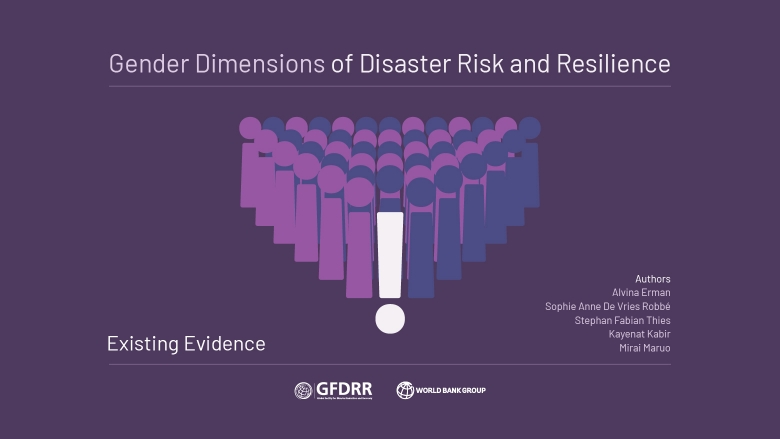Women are not vulnerable in itself and hurricanes, megafires or floods are not misogynistic: a foregone conclusion that should not make us forgetting that we are not all affected equally by natural or man-made disasters. Understanding how gender inequalities drive disaster impacts, and vice versa, is the only way to implement effective policies for building a strong and inclusive resilience.
1 - On Disaster Risk (Management)
"Men and women, boys and girls have different experiences of disasters. Gender dynamics impact both the way they are affected by disasters and their capacity to withstand and recover from them. Gender inequalities can result in gender-differentiated disaster impact, and differentiated impacts can influence gender dynamics, which in turn affect future resilience to shocks. Disaster risk management policies are designed to maximize results, taking local conditions - including gender dynamics - as fixed. When women and men are affected differently by disasters, practitioners and policy makers have a responsibility to use the tools available for mitigating disaster impacts to close gender gaps in outcome. An improved understanding of the gender dynamics of disaster risk and resilience also allows for better policy and program design, which benefits all stakeholders", say the authors of the Report Gender Dimensions of Disaster Risk and Resilience – Existing Evidence published by The World Bank - The Global Facility for Disaster Risk Reduction and Recovery (GFDRR).
When a calamity occurs, disasters impacts and gender inequalities are partially overlaid on each other and drive each other, producing the gender-differentiated impacts of disasters that affect so negatively the women regarding their exposure, vulnerability, prepareness and coping capacity, not forgetting that such gender-differentiated impacts can worsen their resilience to future disasters!
And for good reason, twenty years later, the three takeaways highlighted by Eric Neumayer and Thomas Plümper in their article The Gendered Nature of Natural Disasters: The Impact of Catastrophic Events on the Gender Gap in Life Expectancy, 1981–2002, including that (i) natural disasters kill more women than men or kill women at an earlier age than men, (ii) the stronger the disaster, the more severe impacts on female life expectancy, (iii) higher women's socioeconomic status, the weaker is this effect on the gender gap in life expectancy, are still topical and show how "the socially constructed gender-specific vulnerability of females built into everyday socioeconomic patterns [leads] to the relatively higher female disaster mortality rates compared to men".
To address the problem, the World Bank Report, besides stating that "a good disaster risk management should consider ways in which gender dynamics influence disaster impacts in any given area before making decisions on policy or project design", outlines important strategic and operational priorities to mitigate gender-differentiated impacts of disasters:
- Understand what does and does not work for different population groups by investing more in rigorous impact evaluations and assessments for designing projects.
- Make resources and guidance available to facilitate gender gap assessments in disaster risk management at the country and project level.
- Promote sex and age disaggregated data collection in post-disaster assessments and other disaster related data collection.
- Leverage new data and technologies—such as mobility data—to explore topics, previously understudied, including gendered evacuation patterns and behaviors.
Finally, some main messages from the World Bank Report deserve to be mentioned:
- Resource and structural constraints are the main drivers of gender-differentiated impacts of disasters, particularly when women and girls are disproportionately affected. Biological factors also play a role.
- Although women are in a disadvantage position in society at large, this does not always translate into worse disaster outcomes for women and girls. Men account for 70% of flood-related deaths in Europe and the United States primarily due to overrepresentation of men in rescue professions.
- Women in particular face barriers to access information and resources needed to adequately prepare, respond and cope to a disaster ─ including access to early warning and safe shelter, as well as to bank accounts to protect savings from disasters and stable income.
- Women play an active role in disaster preparedness, response, and recovery efforts. Acknowledging and formalizing their participation can have positive effects on results, as well as positive spillover effects on women’s position in the community.
- Disaster recoveries are opportunities to build back in a way that breaks down the constraints faced by women.
2 - On building Resilience
As stating previously, the gender-differentiated impacts can worsen resilience to future disasters, and even the long-term building resilience.
Dr Debra Parkinson, Alyssa Duncan, Jaspreet Kaur, Emeritus Professor Frank Archer and Dr Caroline Spencer published last January a research they conducted in 2018, that documents disaster experiences of 56 women and men in Australia aged between 18 and 93 years: Gendered aspects of long-term disaster resilience in Victoria, Australia.
"This paper draws out the gendered factors that affected their resilience, and in so doing, begins to address the dearth of research related to gendered aspects of long-term disaster resilience. It is unique in capturing the voices of survivors who spoke of events 9 years after the 2009 Black Saturday fires and of earlier fires and floods in Victoria more than 50 years ago, including the 1983 Ash Wednesday fires. Over decades, gendered expectations of men and women significantly hindered resilience. Men spoke of the long-term cost to them of demands to ‘be strong’ in the worst of disasters and reasons they were reluctant to seek help afterwards. Women spoke of their contributions holding a lesser value and of discrimination. Discussions of violence against women and children after disaster, and suicide ideation in anticipation of future disasters offered critical insights. Protective factors identified by informants were not wholly intrinsic to their character but were also physical, such as essential resources provided in the immediate aftermath, and psychological and community support offered in the long-term. Factors that helped resilience departed from the ‘masculine’ model of coping post-disaster by moving away from a refusal to admit trauma and suffering, to community-wide resilience bolstered by widespread emotional, social and psychological support. Genuine community planning for disasters before they strike builds trust and offers insights for emergency management planners."
Regarding men experiences, the research highlights some important insights, including the two following ones:
- Several civilian men mentioned that, during disasters or in their aftermaths, they were feeling that they were not allowed to show any kind of weakness as they were "expected to be the protector and to fulfil this role unstintingly [and] their destiny on the day was to protect the family or the family home as if this was proof of their manhood". That's why even for some of them, nobody asked how they were going.
- Such feeling from the weight of the society's expectation is also shared by the first responders themselves, in the frame of their activity as emergency services personnel. Despite the hard work and tough context of activity, many men refuse to ask for support, either formal or informal. Murray, one of the interviewees, says that "If I tell someone in the brigade that I’m feeling a certain way, they might likely take me off the rescue. So it’s like, that holds me back".
Concerning the women, here below are some findings outlined by the research:
- Like men, women are more than often stereotyped: while men must protect their family, women must be responsible for the emotional health of the family in the aftermath, "sometimes at great cost to their own autonomy, health and wellbeing".
- In addition to being often reduced to the emotional support of the family, women often experience discrimination in terms of value of their contribution, as if their emotional support was less important than the contribution of men's expected protection. An interviewee tells what a man told her in the aftermath of a flooding: "We’re solving problems and you’re just worrying about your girlfriend or whatever’".
- Women suffer discrimination against them in other ways. The case of Josie is a topical example: she owned her property and cattle before meeting her male partner and in the aftermath of a disaster, when meeting the assessor, that latter separated them to talk to her partner aside and to ask him"What are going to feed [the cattle], how are you going to get water for them, what are you going to do with them?". If you're wondering about the involvement of her partner with the cattle: "None". Stereotypes on emergency management family role is critical for the long-term building resilience.
"It is clear from the accounts for participants in this research that stereotypes of masculinity and femininity in response to disaster remain persistent, defying progress in gender equality. Men are understood as protectors and women as nurturers. Men are frequently unable to admit to experiencing trauma or a sense of failure. They are reluctant to seek help, instead suffering alone, while the responsibility for holding families together is accepted by (or imposed on) women.
Moving away from this outdated model, factors identified by informants as helping resilience related to effective emotional, social and psychological support in a community-wide setting. This has the potential to reduce the stigma felt by men in seeking help and to reduce the imperative of caring felt by women".
***
Sources:
1. Erman, Alvina; De Vries Robbe, Sophie Anne; Thies, Stephan Fabian; Kabir, Kayenat; Maruo, Mirai. 2021. Gender Dimensions of Disaster Risk and Resilience : Existing Evidence. World Bank, Washington, DC. © World Bank. https://openknowledge.worldbank.org/handle/10986/35202 License: CC BY 3.0 IGO.
2. Dr Debra Parkinson, Alyssa Duncan, Jaspreet Kaur, Emeritus Professor Frank Archer and Dr Caroline Spencer. 2022. Gendered aspects of long-term disaster resilience in Victoria, Australia. Australian Journal of Emergency Management, Volume 37, N.1, January 2022. http://www.doi.org/10.47389/37.1.59.
3. Eric Neumayer & Thomas Plümper (2007) The Gendered Nature of Natural Disasters: The Impact of Catastrophic Events on the Gender Gap in Life Expectancy,1981–2002, Annals of the Association of American Geographers, 97:3, 551-566, DOI: 10.1111/j.1467-8306.2007.00563.x.

